An official website of the United States government
 United States Department of Labor
United States Department of Labor
Drive logging tractor or wheeled vehicle equipped with one or more accessories, such as bulldozer blade, frontal shear, grapple, logging arch, cable winches, hoisting rack, or crane boom, to fell tree; to skid, load, unload, or stack logs; or to pull stumps or clear brush. Includes operating stand-alone logging machines, such as log chippers. Logging truck drivers are included in “Heavy and Tractor-Trailer Truck Drivers” (53-3032).
Employment estimate and mean wage estimates for Logging Equipment Operators:
| Employment (1) | Employment RSE (3) |
Mean hourly wage |
Mean annual wage (2) |
Wage RSE (3) |
|---|---|---|---|---|
| 25,510 | 2.2 % | $ 21.14 | $ 43,960 | 1.1 % |
Percentile wage estimates for Logging Equipment Operators:
| Percentile | 10% | 25% | 50% (Median) |
75% | 90% |
|---|---|---|---|---|---|
| Hourly Wage | $ 13.85 | $ 17.26 | $ 22.31 | $ 23.45 | $ 29.36 |
| Annual Wage (2) | $ 28,810 | $ 35,890 | $ 46,400 | $ 48,770 | $ 61,070 |
Industries with the highest published employment and wages for Logging Equipment Operators are provided. For a list of all industries with employment in Logging Equipment Operators, see the Create Customized Tables function.
Industries with the highest levels of employment in Logging Equipment Operators:
| Industry | Employment (1) | Percent of industry employment | Hourly mean wage | Annual mean wage (2) |
|---|---|---|---|---|
| Logging | 19,290 | 40.96 | $ 21.85 | $ 45,460 |
| Sawmills and Wood Preservation | 3,510 | 3.99 | $ 17.02 | $ 35,400 |
| Services to Buildings and Dwellings | 960 | 0.04 | (8) | (8) |
| Employment Services | 410 | 0.01 | $ 16.67 | $ 34,660 |
| Truck Transportation | 260 | 0.02 | $ 21.20 | $ 44,100 |
Industries with the highest concentration of employment in Logging Equipment Operators:
| Industry | Employment (1) | Percent of industry employment | Hourly mean wage | Annual mean wage (2) |
|---|---|---|---|---|
| Logging | 19,290 | 40.96 | $ 21.85 | $ 45,460 |
| Sawmills and Wood Preservation | 3,510 | 3.99 | $ 17.02 | $ 35,400 |
| Veneer, Plywood, and Engineered Wood Product Manufacturing | 180 | 0.23 | $ 22.43 | $ 46,660 |
| Other Wood Product Manufacturing | 180 | 0.08 | $ 15.57 | $ 32,380 |
| Services to Buildings and Dwellings | 960 | 0.04 | (8) | (8) |
Top paying industries for Logging Equipment Operators:
| Industry | Employment (1) | Percent of industry employment | Hourly mean wage | Annual mean wage (2) |
|---|---|---|---|---|
| Veneer, Plywood, and Engineered Wood Product Manufacturing | 180 | 0.23 | $ 22.43 | $ 46,660 |
| Logging | 19,290 | 40.96 | $ 21.85 | $ 45,460 |
| Truck Transportation | 260 | 0.02 | $ 21.20 | $ 44,100 |
| Other Specialty Trade Contractors | 170 | 0.02 | $ 20.58 | $ 42,810 |
| Sawmills and Wood Preservation | 3,510 | 3.99 | $ 17.02 | $ 35,400 |
States and areas with the highest published employment, location quotients, and wages for Logging Equipment Operators are provided. For a list of all areas with employment in Logging Equipment Operators, see the Create Customized Tables function.
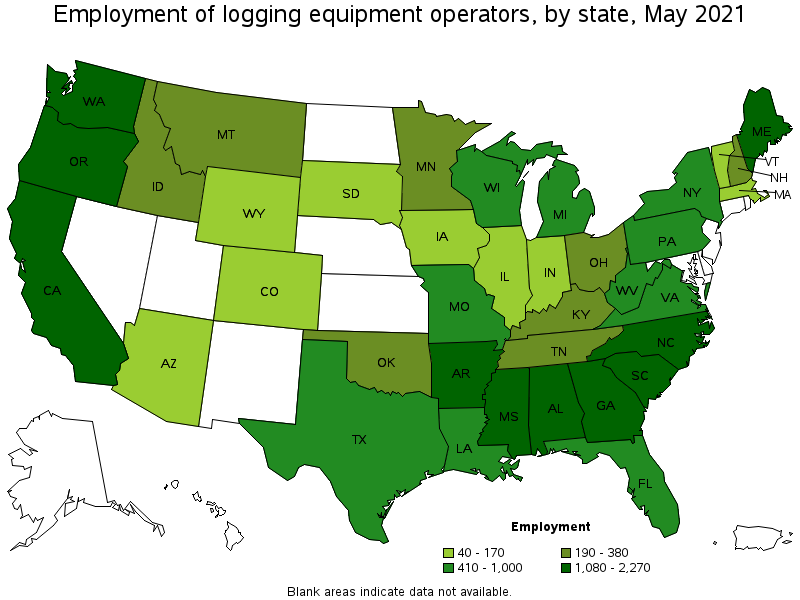
States with the highest employment level in Logging Equipment Operators:
| State | Employment (1) | Employment per thousand jobs | Location quotient (9) | Hourly mean wage | Annual mean wage (2) |
|---|---|---|---|---|---|
| Alabama | 2,270 | 1.18 | 6.49 | $ 19.26 | $ 40,050 |
| Georgia | 1,970 | 0.45 | 2.48 | $ 21.87 | $ 45,480 |
| Oregon | 1,820 | 1.00 | 5.52 | $ 24.71 | $ 51,390 |
| North Carolina | 1,740 | 0.39 | 2.17 | $ 19.02 | $ 39,570 |
| Mississippi | 1,650 | 1.50 | 8.29 | $ 19.33 | $ 40,200 |
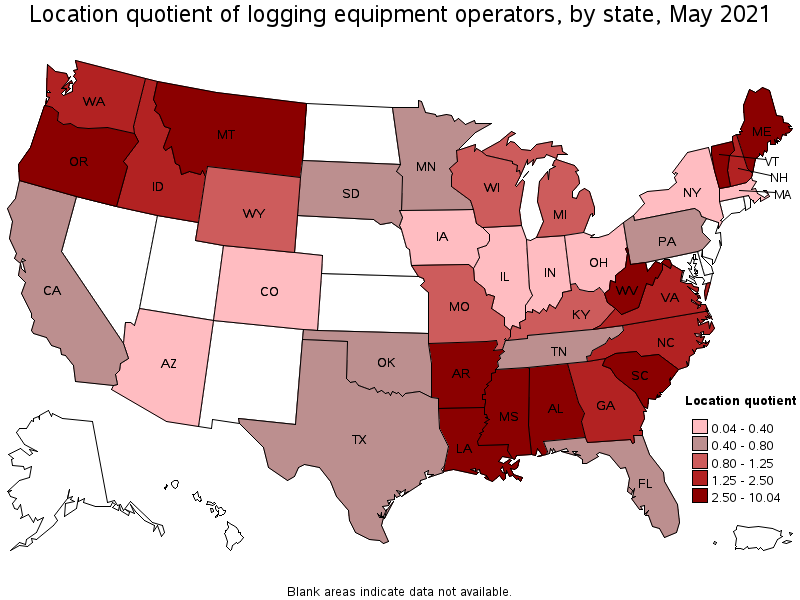
States with the highest concentration of jobs and location quotients in Logging Equipment Operators:
| State | Employment (1) | Employment per thousand jobs | Location quotient (9) | Hourly mean wage | Annual mean wage (2) |
|---|---|---|---|---|---|
| Maine | 1,080 | 1.82 | 10.04 | $ 19.59 | $ 40,750 |
| Mississippi | 1,650 | 1.50 | 8.29 | $ 19.33 | $ 40,200 |
| Alabama | 2,270 | 1.18 | 6.49 | $ 19.26 | $ 40,050 |
| Oregon | 1,820 | 1.00 | 5.52 | $ 24.71 | $ 51,390 |
| Arkansas | 1,100 | 0.93 | 5.11 | $ 21.38 | $ 44,480 |
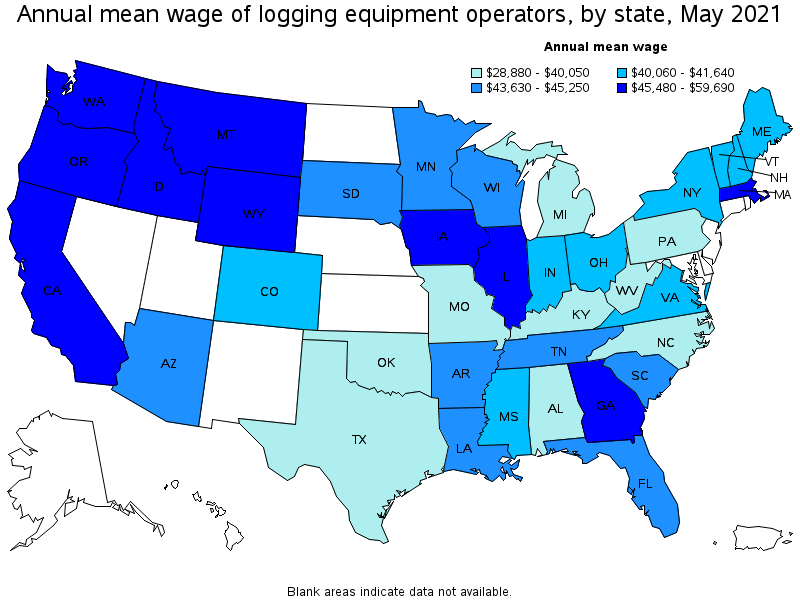
Top paying states for Logging Equipment Operators:
| State | Employment (1) | Employment per thousand jobs | Location quotient (9) | Hourly mean wage | Annual mean wage (2) |
|---|---|---|---|---|---|
| Idaho | 280 | 0.37 | 2.04 | $ 28.70 | $ 59,690 |
| Washington | 1,330 | 0.41 | 2.29 | $ 27.69 | $ 57,600 |
| California | 1,530 | 0.09 | 0.51 | $ 26.79 | $ 55,730 |
| Oregon | 1,820 | 1.00 | 5.52 | $ 24.71 | $ 51,390 |
| Montana | 340 | 0.71 | 3.94 | $ 24.36 | $ 50,660 |
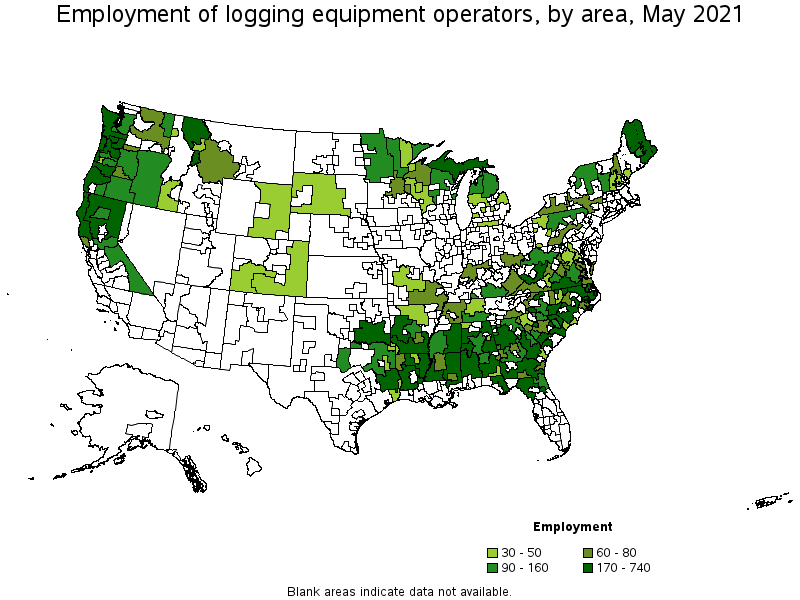
Metropolitan areas with the highest employment level in Logging Equipment Operators:
| Metropolitan area | Employment (1) | Employment per thousand jobs | Location quotient (9) | Hourly mean wage | Annual mean wage (2) |
|---|---|---|---|---|---|
| Portland-Vancouver-Hillsboro, OR-WA | 270 | 0.24 | 1.32 | $ 26.35 | $ 54,810 |
| Eugene, OR | 250 | 1.67 | 9.24 | $ 24.28 | $ 50,510 |
| Atlanta-Sandy Springs-Roswell, GA | 240 | 0.09 | 0.51 | $ 21.20 | $ 44,100 |
| Tuscaloosa, AL | 230 | 2.40 | 13.28 | $ 17.78 | $ 36,970 |
| Longview, WA | 180 | 4.66 | 25.72 | $ 30.18 | $ 62,780 |
| Seattle-Tacoma-Bellevue, WA | 160 | 0.08 | 0.46 | $ 28.72 | $ 59,740 |
| Augusta-Richmond County, GA-SC | 150 | 0.69 | 3.79 | $ 21.20 | $ 44,090 |
| Redding, CA | 150 | 2.29 | 12.66 | $ 23.21 | $ 48,280 |
| Birmingham-Hoover, AL | 150 | 0.31 | 1.70 | $ 20.97 | $ 43,610 |
| Spokane-Spokane Valley, WA | 140 | 0.60 | 3.30 | $ 25.96 | $ 54,000 |
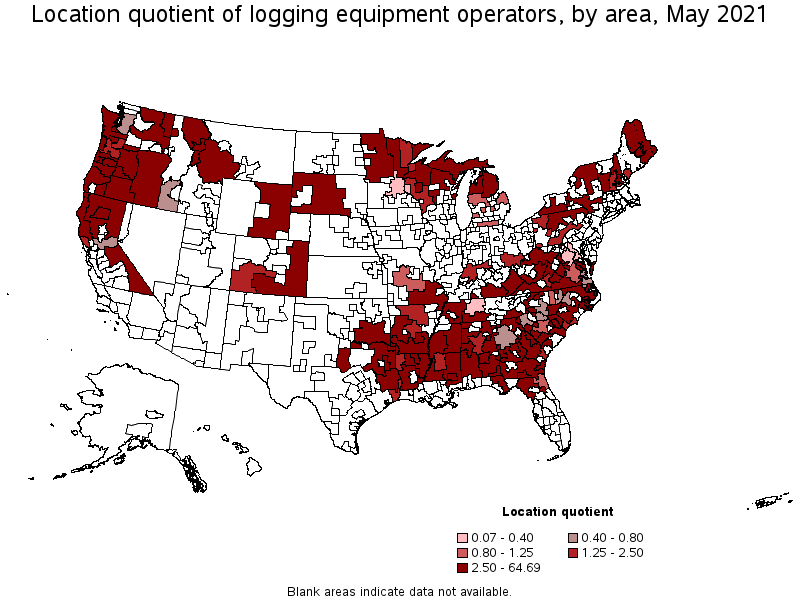
Metropolitan areas with the highest concentration of jobs and location quotients in Logging Equipment Operators:
| Metropolitan area | Employment (1) | Employment per thousand jobs | Location quotient (9) | Hourly mean wage | Annual mean wage (2) |
|---|---|---|---|---|---|
| Longview, WA | 180 | 4.66 | 25.72 | $ 30.18 | $ 62,780 |
| Albany, OR | 130 | 2.93 | 16.20 | $ 24.85 | $ 51,690 |
| Tuscaloosa, AL | 230 | 2.40 | 13.28 | $ 17.78 | $ 36,970 |
| Redding, CA | 150 | 2.29 | 12.66 | $ 23.21 | $ 48,280 |
| Pine Bluff, AR | 60 | 2.10 | 11.60 | $ 20.51 | $ 42,650 |
| Eugene, OR | 250 | 1.67 | 9.24 | $ 24.28 | $ 50,510 |
| New Bern, NC | 70 | 1.67 | 9.22 | $ 20.07 | $ 41,740 |
| Medford, OR | 140 | 1.58 | 8.71 | $ 24.16 | $ 50,260 |
| Brunswick, GA | 60 | 1.47 | 8.14 | $ 21.90 | $ 45,550 |
| Bangor, ME | 90 | 1.45 | 8.01 | $ 20.21 | $ 42,040 |
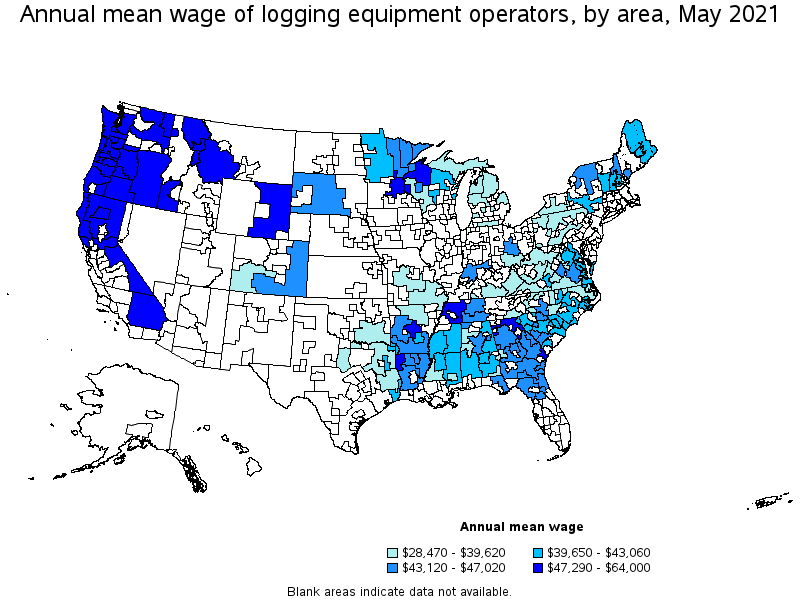
Top paying metropolitan areas for Logging Equipment Operators:
| Metropolitan area | Employment (1) | Employment per thousand jobs | Location quotient (9) | Hourly mean wage | Annual mean wage (2) |
|---|---|---|---|---|---|
| Santa Rosa, CA | 60 | 0.30 | 1.67 | $ 30.77 | $ 64,000 |
| Riverside-San Bernardino-Ontario, CA | (8) | (8) | (8) | $ 30.25 | $ 62,910 |
| Longview, WA | 180 | 4.66 | 25.72 | $ 30.18 | $ 62,780 |
| Olympia-Tumwater, WA | 110 | 0.96 | 5.30 | $ 29.65 | $ 61,680 |
| Seattle-Tacoma-Bellevue, WA | 160 | 0.08 | 0.46 | $ 28.72 | $ 59,740 |
| Coeur d'Alene, ID | 40 | 0.57 | 3.17 | $ 28.69 | $ 59,670 |
| Sacramento--Roseville--Arden-Arcade, CA | 130 | 0.13 | 0.74 | $ 27.76 | $ 57,730 |
| Corvallis, OR | 40 | 1.18 | 6.54 | $ 27.33 | $ 56,840 |
| Portland-Vancouver-Hillsboro, OR-WA | 270 | 0.24 | 1.32 | $ 26.35 | $ 54,810 |
| Salem, OR | 120 | 0.70 | 3.89 | $ 26.08 | $ 54,250 |
Nonmetropolitan areas with the highest employment in Logging Equipment Operators:
| Nonmetropolitan area | Employment (1) | Employment per thousand jobs | Location quotient (9) | Hourly mean wage | Annual mean wage (2) |
|---|---|---|---|---|---|
| Southwest Alabama nonmetropolitan area | 740 | 11.71 | 64.69 | $ 19.73 | $ 41,040 |
| South Georgia nonmetropolitan area | 620 | 3.39 | 18.73 | $ 22.25 | $ 46,280 |
| Coast Oregon nonmetropolitan area | 620 | 5.61 | 30.97 | $ 24.44 | $ 50,840 |
| Southeast Mississippi nonmetropolitan area | 590 | 4.11 | 22.67 | $ 19.90 | $ 41,390 |
| Central Louisiana nonmetropolitan area | 550 | 7.48 | 41.29 | $ 20.87 | $ 43,410 |
Nonmetropolitan areas with the highest concentration of jobs and location quotients in Logging Equipment Operators:
| Nonmetropolitan area | Employment (1) | Employment per thousand jobs | Location quotient (9) | Hourly mean wage | Annual mean wage (2) |
|---|---|---|---|---|---|
| Southwest Alabama nonmetropolitan area | 740 | 11.71 | 64.69 | $ 19.73 | $ 41,040 |
| Northeast Maine nonmetropolitan area | 540 | 8.04 | 44.38 | $ 19.43 | $ 40,400 |
| Central Louisiana nonmetropolitan area | 550 | 7.48 | 41.29 | $ 20.87 | $ 43,410 |
| Coast Oregon nonmetropolitan area | 620 | 5.61 | 30.97 | $ 24.44 | $ 50,840 |
| South Arkansas nonmetropolitan area | 500 | 5.50 | 30.39 | $ 21.31 | $ 44,330 |
Top paying nonmetropolitan areas for Logging Equipment Operators:
| Nonmetropolitan area | Employment (1) | Employment per thousand jobs | Location quotient (9) | Hourly mean wage | Annual mean wage (2) |
|---|---|---|---|---|---|
| Western Washington nonmetropolitan area | 480 | 4.01 | 22.16 | $ 27.02 | $ 56,200 |
| North Coast Region of California nonmetropolitan area | 340 | 3.44 | 19.00 | $ 25.44 | $ 52,910 |
| Eastern Washington nonmetropolitan area | 80 | 0.86 | 4.73 | $ 25.27 | $ 52,550 |
| North Valley-Northern Mountains Region of California nonmetropolitan area | 300 | 3.07 | 16.97 | $ 25.12 | $ 52,250 |
| Northwestern Wisconsin nonmetropolitan area | 60 | 1.37 | 7.58 | $ 24.61 | $ 51,180 |
These estimates are calculated with data collected from employers in all industry sectors, all metropolitan and nonmetropolitan areas, and all states and the District of Columbia. The top employment and wage figures are provided above. The complete list is available in the downloadable XLS files.
The percentile wage estimate is the value of a wage below which a certain percent of workers fall. The median wage is the 50th percentile wage estimate—50 percent of workers earn less than the median and 50 percent of workers earn more than the median. More about percentile wages.
(1) Estimates for detailed occupations do not sum to the totals because the totals include occupations not shown separately. Estimates do not include self-employed workers.
(2) Annual wages have been calculated by multiplying the hourly mean wage by a "year-round, full-time" hours figure of 2,080 hours; for those occupations where there is not an hourly wage published, the annual wage has been directly calculated from the reported survey data.
(3) The relative standard error (RSE) is a measure of the reliability of a survey statistic. The smaller the relative standard error, the more precise the estimate.
(8) Estimate not released.
(9) The location quotient is the ratio of the area concentration of occupational employment to the national average concentration. A location quotient greater than one indicates the occupation has a higher share of employment than average, and a location quotient less than one indicates the occupation is less prevalent in the area than average.
Other OEWS estimates and related information:
May 2021 National Occupational Employment and Wage Estimates
May 2021 State Occupational Employment and Wage Estimates
May 2021 Metropolitan and Nonmetropolitan Area Occupational Employment and Wage Estimates
May 2021 National Industry-Specific Occupational Employment and Wage Estimates
Last Modified Date: March 31, 2022